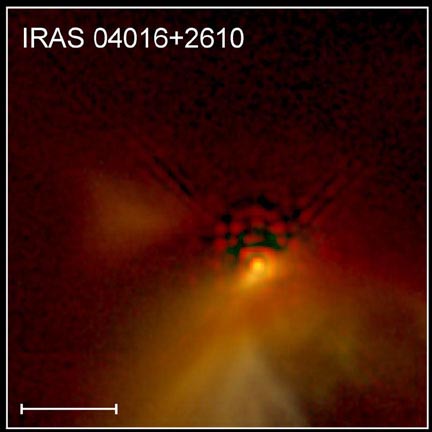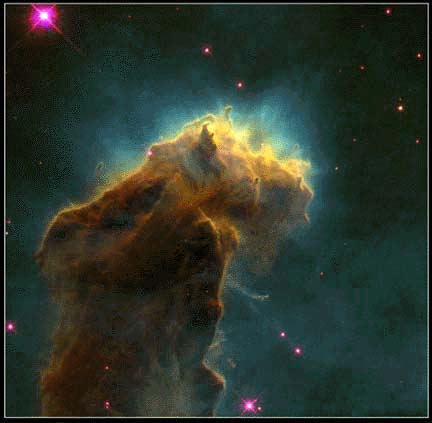The
Formation of Stars
&
Open
Star Clusters
This
is an image of a newborn star still in its cocoon.
Star
Clusters & Stars
Open star clusters are
some of the youngest pieces of the universe. Astronomers have found
open clusters situated along the
spiral arms of the galaxy, and sometimes refer to them as galactic clusters.
Many star clusters contain hundreds of stars.
The study of galactic clusters is extremely important in the study of the
evolution of the stars.
Most open clusters
are situated within dust clouds called reflection nebulae. These
reflection nebulae appear as a blue haze.
This is because dust particles in space reflect blue light easier than
red light. Stars form within gas clouds called dark
nebulae. Dark nebulae cannot be seen without special equipment.
The clouds are so dense they absorb any nearby starlight,
so stars actually seem to hide behind them. Dark nebulae are barely
dense and cold enough to begin the chemical
process of star birth. (Kaufmann, 498)
Interstellar dust
clouds actually come as an enigma to scientists, because of the near vacuum
medium the particles travel through
to combine and form clouds. Strong forces must play an essential
role in their formation. The stellar winds from dying
redgiant stars (as they are burning off their last remnants of heavy elements
they blast into interstellar space) are one
example of the type of force needed. As these heavier elements cool off,
they recombine as molecular dust particles. Over
time they become increasingly dense and ionize from the starlight of nearby
stars hitting m. Gravitational forces continually
pull the dust and gas toward the central part of the nebulae. As
more particles combine, the more friction is created
and thermal heat can begin. (Kaufmann, 498)
This thermal heat
is the beginning of the star formation called a protostar. Protostars
begin very large and condense through
time. As they condense, they give off energy. They have not
yet begun to create thermonuclear energy, which stars
like our sun generate. These protostars are called T Tauri stars.
Nebulae are rather large and can churn out many of these
protostars. This is how an open cluster forms. As the protostars
increase in temperature, until they reach main sequence
temperatures, they illuminate their surface through the process of fusion.
(Kaufmann, 504)
The emission of photons
from the older stars within the cluster can effect the formation of the
protostars. The photons blast
away dark nebulae, which is the seed of stellar formation (Kaufmann, 504).
This can cause a smaller star to form.
The stars within a
cluster have barely enough gravitational pull to keep them together (Frommert,
Online). This can create
a rather large spread of open cluster members. The average age of a cluster
is approximately 100 million years (Frommert,
Online). This makes sense, because as stars are created they drift further
and further from each other. These stars
continue drifting until they are no longer within the grasp of the gravitational
forces of the clusters. The star constellation
Ursa Major is actually part of a vastly spread out (23 degrees) open star
cluster. (Fortier, 79)
These images
are from the Nebula M16. Note that each poked out area is a stellar nursery,
or a pocket housing a protostar.
Chemical
Reaction
Two types of interstellar
clouds form from the red giant stellar blast. Cirrus nebulae consist
of dense particles, which absorb
light. Diffuse nebulae contain both gas and particles, but are inherently
much more dense. They both contain a high
abundance of CO, carbon monoxide (Verschuur, 381). The hydrogen element
is the most abundant element found in the
universe. Astronomers use CO to detect the presence of the H2 molecule
(two hydrogen atoms).
As these clouds condense
into colder matter, they combine and form into a type of dark nebulae called
Bok globules. This
density causes pockets within the nebulae, which become the cocoons for
protostars (Verschuur, 381). This process can
be initiated by the ionization from starlight. Ionization means that
the elements or molecules have become charged either
positively or negatively. This can lead to other chemical reactions
as positive and negative charges attract.
The density of the
molecules within the Bok nebulae establishes the reactivity of them and
the energy radiating from the clouds.
As the energy increases, the electrons within the atoms vibrate more rapidly.
This is what causes the initial energy forming protostars (see figure 1).
MADE BY: Sara Petty-Powell
and Christina Pince
LAST MODIFIED: 23*May*1999
@ 6:00 p.m. (PST)


